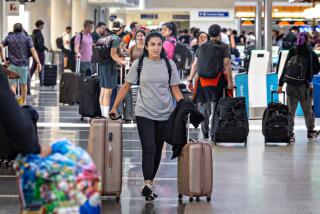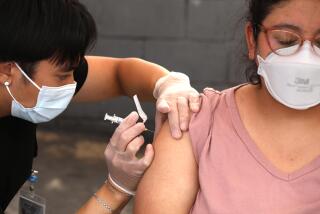Sick? Don’t fly. But if you must, get prepped before takeoff
- Share via
Your flight departs tomorrow, but your problems arrived today: Your nose is running, a temporary dental crown is hurting or your toddler has an ear infection.
To fly or not to fly? Seemingly minor health issues can be aggravated by changes in altitude and other realities of travel, eventually developing into painful problems.
With cold and flu season approaching, a few experts have provided some guidelines to help you decide whether to leave home and how to minimize the misery if you must travel while you’re sick:
* Fever: “If you’re an adult and have a body temperature over 100 degrees, you should probably stay home,” says Dr. Mary Frank, a family physician in Rohnert Park, Calif., and president of the American Academy of Family Physicians. “If you travel when ill, you risk getting complications, such as pneumonia after the flu or having a cold turn into a sinus infection.”
* Eardrums: Flying with a cold or the flu can pose a risk, Frank says. The eustachian tube, which connects the middle ear with the upper throat and equalizes eardrum pressure, can swell. “As cabin pressure changes, the eardrum usually adjusts,” she says. “But with swelling, it can’t adjust to these pressure changes, and the drum may rupture.”
* Dental work: If you’ve had a filling, tooth extraction or root canal recently, ask your dentist how long you should wait before flying, says Edmond Hewlett, associate professor at the UCLA School of Dentistry and a spokesman for the American Dental Assn. If someone needs stitches after having a wisdom tooth removed, for example, Hewlett recommends not flying for a couple of days to avoid pain, swelling or bleeding.
* Crowns: A traveler with a temporary crown usually can fly immediately, Hewlett says, “but it’s important to let the dentist know you are traveling.” Your dentist might use a stronger cement on the crown, he says.
* Cosmetic surgery: Flying soon after cosmetic surgery is not a good idea, says Dr. Rod Rohrich, president of the American Society of Plastic Surgeons and chairman of plastic surgery at the University of Texas Southwestern Medical Center at Dallas. The recommended wait varies with the procedure, but Rohrich typically suggests a five- to seven-day wait after liposuction or breast augmentation.
He also recommends not flying for seven to 10 days after eyelid surgery, rhinoplasty (a nose job), a face-lift or facial laser treatments, to prevent complications such as swelling or infection.
These precautions notwithstanding, family emergencies, urgent business or expensive vacations sometimes force us to travel even when ill. Experts suggest that you check with your doctor about prescription medications or over-the-counter products to pack. Other tips:
* Treat symptoms before takeoff. If you have a cold, take a decongestant about an hour before getting on the plane, family physician Frank says. Use an over-the-counter nasal spray 30 to 60 minutes before departure, she adds, and wear earplugs during takeoff and landing to reduce pressure on the eardrums.
* If you must fly when your child has a cold, ask your pediatrician about using nasal sprays or decongestants before takeoff, Frank says. Be sure infants suck on a pacifier or bottle during takeoff and landing to ease pressure on the eardrum.
* If you’re flying with a temporary dental crown, take along over-the-counter dental cement in case the crown gets dislodged, the dental association’s Hewlett says.
Healthy Traveler appears every other week. Kathleen Doheny can be reached at kathleendoheny@earthlink.net.
More to Read
Sign up for The Wild
We’ll help you find the best places to hike, bike and run, as well as the perfect silent spots for meditation and yoga.
You may occasionally receive promotional content from the Los Angeles Times.






